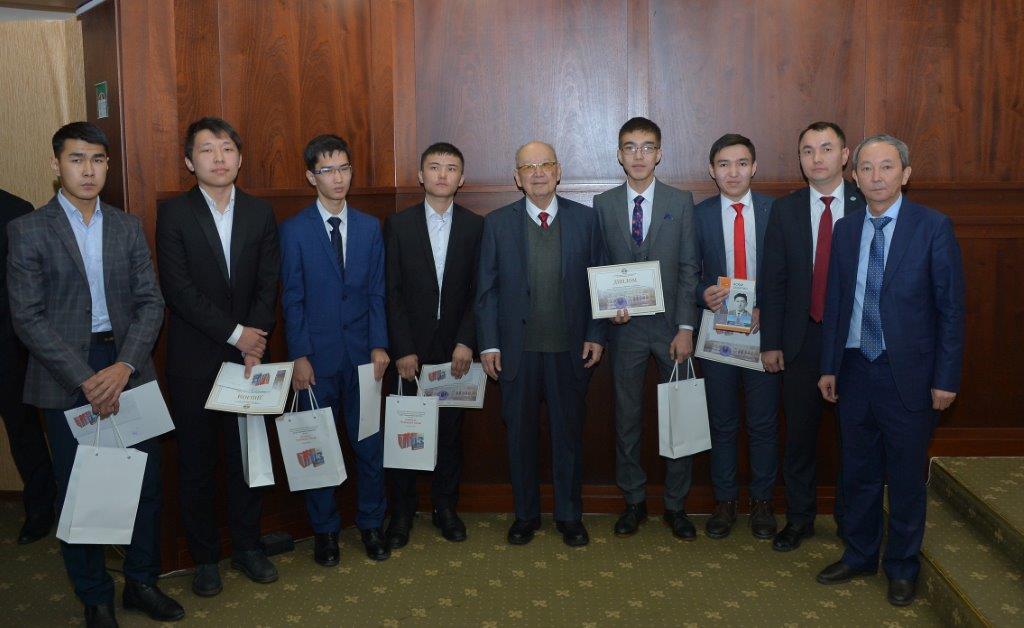Let us remind you, that the contest winners will have the opportunity to complete the first basic actuarial course with the following exam for free. With its successful delivery, they will also be able to take a second basic course of the minimum training program for actuaries in the Republic of Kazakhstan on a grant basis. Citizens of the Republic of Kazakhstan, born not earlier than 1994, the last year Bachelor’s program students of higher education institutions or graduates, postgraduates in Master's or PhD programs with a high GPA score (average score) are allowed to take part in the competition. Priority disciplines are mathematics, and physics. Also, the selection will take into account the prize places in Olympiads (school academic competitions), projects in mathematics, physics and the availability of free time to take the full course program. All details about the contest are available at: www.actuary-grant.kz.
- Mirbulat Bakhytzhanovich, you teach actuarial mathematics to students. Could you tell me about the subject, and why is not the economy but mathematics so important in the work of an actuary?
- When, for the first time in Kazakhstan, in the early 2000s they announced admission for actuarial courses, they mostly accepted economists, financiers, and mathematicians were admitted the least. Another condition was the knowledge of English, as the lectures were held in this language. The courses were organized by the National Bank of the Republic of Kazakhstan and the United States Agency for International Development (USAID). As a result, only 12-13 people out of 50 students passed examinations, and almost all of them were mathematicians or people with a good basic mathematical education. When later we started organizing actuarial courses ourselves, we admitted mostly mathematicians. The reason is simple. The weakness of all our universities with economic specialties is that they, unfortunately, have stopped teaching mathematics: probability theory, mathematical statistics, and mathematical analysis. That is why most of their graduates cannot study at our courses. And to become a good actuary, it takes to be a good mathematician and researcher. For example, our mathematician, Candidate of Physical and Mathematical Sciences, whom I worked with in Kazak National University, Makhmud Sagyndyk, together with his wife, is now working as actuary in the US government. He is a member of the Society of Actuaries of the United States.
Now in the insurance market, most licensed actuaries are graduates from mathematical faculties.
The minimum training program for actuaries of the National Bank of the Republic of Kazakhstan, adopted in the early 2000s, includes 6 courses and 10 exams. The programs of the first 5 courses of them require good knowledge of mathematics. All actuarial tasks are related to calculations, and they are based on purely mathematical calculations: theory of probability, math statistics, and others.
- What are the actuarial courses? What should the future specialists learn from the basic course and for what period?
- Two first of these 6 courses are basic. And, as practice shows, those who could master and pass the exams on these two courses have great chances to successfully complete the remaining 4 courses and become licensed actuaries. Therefore, our task now is to select people who will be able to complete two basic courses.
The first actuaries in Kazakhstan used to receive licenses on the basis of these two first courses. Therefore, these courses contain all the most necessary materials to start working as an actuary. For instance, the first course includes the basics of financial mathematics: the theory of interest, financial annuities, loan repayment, bonds. Next are the fundamentals of the life insurance theory: mortality tables and methods of their construction, insurance annuities, life insurance, joint insurance annuities, and application of annuities to the retirement plans.
Insurance is divided into two branches: general insurance and life insurance. The second basic course provides basic knowledge on all the main issues and tasks of these insurance sectors, in particular: insurance products pricing, reserves, loss reserve estimation methods, reinsurance, investment theory, insurance annuities (more in-depth).
Those who graduated from these two basic courses can start working as newcomer actuaries, interns in insurance companies. Usually it works exactly this way. Insurance companies in our country are willing to hire the basic course graduates, and then these specialists can either pay for their own training on the remaining 4 actuarial courses, or these expenses are borne by their company, as it is interested in cultivating qualified personnel.
Such specialists can also work, for example, as risk managers, underwriters, or specialists of reinsurance department.
- Why did the course sponsor put forward such strict/high requirements to applicants?
- This is correct. I gave an example above, when the selection parameters for the very first courses of actuaries were not set correctly, a lot of money for training was spent, but only a small part of the graduates was able to pass the exams. In order to avoid this situation in future, it is important to establish high requirements to applicants at the selection stage.
- What is percentage of students who take this course? What is the reason for this?
- It depends on the course and the level of training of students. The statistics show that only 15-20% of the students successfully pass the exam on the first basic course from the first time. And the progress in the second course is more than 50%. But there is an opportunity to take the exams again.
- What is necessary for the successful completion of the courses?
- Of course, one good basic mathematical education cannot always be the guarantee for successful passing exams. And one of the reasons is the high intensity level of these courses. The total volume of actuarial courses is 144 hours, which must be attended within 3 weeks and one more week for preparation for the qualifying exam. It means that all these days, almost a month, will be dedicated to studying. That is, 8 hours a day, plus a lot of homework, approximately 12-16 hours a day in total. Unfortunately, our young people are not ready for such a hard training schedule.
If we make longer courses, it will allow us to reduce the intensity of the loads, the cost of training, however, will automatically increase, as additional costs for teachers' salaries and other expenses will follow.
- The competition organizer pays for the basic course of 50 qualified students. Is there really a shortage of personnel in this trade today? What are the reasons for that?
- For the last 5-6 years they have practically stopped training the actuaries in our market. As a result, there is an acute shortage of personnel in the entire insurance market. Unfortunately, none of universities of Kazakhstan prepare actuaries, specialists for insurance companies. The very preparation for the introduction of such discipline in universities can take a lot of time; it is necessary to prepare the appropriate theoretical background, find teachers, and pass a long approval process. This can take several years. Therefore, it is important that future actuaries, first of all, get a good mathematical education in higher education institutions, and the rest they will learn in actuarial courses.
As you know, it is all about the workforce, especially in insurance companies. Now the level of risks (loss of property, damage to health, defaults on mortgages, etc.) is growing all over the world. And, in order to reduce their consequences, you need to be able to predict risks, and, most importantly, manage them in complex, critical situations. And for this we need competent specialists.
- What do these courses give to future specialists? What prospects do they open?
- Do not be afraid to work on yourself and raise your professional level. If today young people have a problem with employment, it is their fault in the first place. If you want to get a good salary, you have to comply: you need to study, as one diploma for life is not enough anymore; you need to constantly improve your skills, because the modern world is rapidly changing, as well as its demands and needs. For example, I know many guys who are preparing for a certified financial analyst (CFA) international exam, passing which will open the door to international financial organizations.
As for the perspective of the profession of an actuary, for example, in the US it is at the top of the leading occupations in the country, taking into account different preferences when choosing a job. And of course, it is one of the well-paid jobs. In Kazakhstan, for example, a highly qualified employee with a national higher education degree with a big experience of 15-20 years get a salary of around 150 thousand tenge. An assistant to an actuary, who graduated the relevant courses, have approximately the same salary in insurance companies, not to mention the prospects of a licensed actuary. By the way, Kairat Chegebayev, the Chairman of the Board of the JSC "LIC "NOMAD LIFE", a graduate from the Faculty of Mathematics of Kazak State University, is a licensed actuary.
- What do you think of allocating grants for training by NOMAD LIFE Company?
- This is a very good start. Having invested in the training of actuaries today, in 2-3 years the company will recoup its investments with good personnel. We hope that other insurance companies, seeing the results, will support this initiative. You cannot live for the day. Weak specialists will sooner or later affect the financial performance of the company. Investments in human capital, as world practice has shown, are always justified.
- How did you come to this mathematician profession and what difficulties did you face?
- I graduated from the Faculty of Mechanics and Mathematics, Kazak National University in 1982 with degree with honors, my average score was 5.0, i.e. the highest one. I had my internship, got my postgraduate degree and about six years later became a Candidate of Physical and Mathematical Sciences of the USSR with a good for those times salary of about 300 rubles. Let me remind you that the average salary of a simple engineer was 150 rubles. After the Soviet Union collapse, when our diplomas became useless to anyone, in order to support my family I had to work in sales. After 6 years, having provided the family with a more or less decent standard of living, I again started thinking of returning to science. All this time I have been receiving invitations from the university for teaching, and even taught students, but not on an ongoing basis. And the time when I was not short of money and could again devote myself to science came, otherwise it would be a shame to waste my well-earned diploma with honors. And, in general, we, people born and raised in Soviet era, wanted to serve our country (smiling). I had no goal to make all the money in the world (smiles).
I returned to my native department. When I had learned about actuarial mathematics, I passed relevant courses, and then participated in organizing these courses not only in Kazakhstan, but also in the Kyrgyz Republic and Azerbaijan. Now I again prepare future specialists in mathematics at the university in parallel working on introduction of the actuary discipline on the basis of Faculty of Mechanics and Mathematics at Al Farabi Kazak State University. We already present two basic actuarial courses on the Bachelor’s program along the trajectory "actuarial mathematics" to mathematic students. We opened Master’s program with more profound actuarial science teaching; the opening of PhD program is in plans. Now many students of Mathematics Faculty start to realize the prospects of the actuarial profession, therefore, probably, soon we will open an actuary major in the Faculty.





